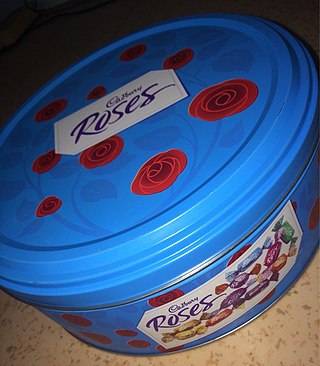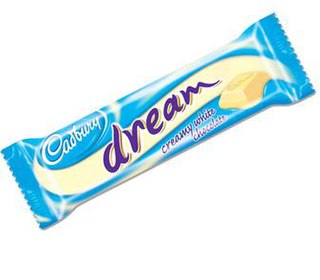
Cadbury, formerly Cadbury's and Cadbury Schweppes, is a British multinational confectionery company owned by Mondelez International since 2010. It is the second-largest confectionery brand in the world, after Mars. Cadbury is internationally headquartered in Greater London, and operates in more than 50 countries worldwide. It is known for its Dairy Milk chocolate, the Creme Egg and Roses selection box, and many other confectionery products. One of the best-known British brands, in 2013 The Daily Telegraph named Cadbury among Britain's most successful exports.

Freddo is a chocolate bar brand shaped like an anthropomorphic cartoon frog. It was originally manufactured by the now defunct company MacRobertson's, an Australian confectionery company, but is now produced by Cadbury. Some of the more popular flavours include strawberry, pineapple and peppermint.

Milk chocolate is a form of solid chocolate containing cocoa, sugar and milk. It is the most consumed type of chocolate, and is used in a wide diversity of bars, tablets and other confectionery products. Milk chocolate contains smaller amounts of cocoa solids than dark chocolates do, and contains milk solids. While its taste has been key to its popularity, milk chocolate was historically promoted as a healthy food, particularly for children.

Kit Kat is a chocolate-covered wafer bar confection created by Rowntree's of York, England. It is produced globally by Nestlé, except in the United States, where it is made under licence by the H. B. Reese Candy Company, a division of the Hershey Company.

Cadbury Dairy Milk is a British brand of milk chocolate manufactured by Cadbury. It was introduced in the United Kingdom in June 1905 and now consists of a number of products. Every product in the Dairy Milk line is made with exclusively milk chocolate. In 1928, Cadbury's introduced the "glass and a half" slogan to accompany the Dairy Milk chocolate bar, to advertise the bar's higher milk content.
Flake is a British brand of chocolate bar currently manufactured by British chocolate company Cadbury, owned by Mondelez International, consisting of thinly folded milk chocolate. The bar has a unique crumbly texture, and softens but does not melt when heated.

Cadbury Creme Egg is a chocolate confection produced in the shape of an egg. It originated from the British chocolatier Fry's in 1963 before being renamed by Cadbury in 1971. The product consists of a thick chocolate shell containing a sweet white and yellow filling that resembles fondant. The filling mimics the albumen and yolk of a soft boiled egg.
Wispa is a brand of chocolate bar manufactured by British chocolate company Cadbury. Using aerated chocolate, the bar was launched in 1981 as a trial version in North East England, and with its success it was introduced nationally in 1983. It was seen as a competitor to Rowntree's Aero . In 2003, as part of a relaunch of the Cadbury Dairy Milk brand, the Wispa brand was discontinued and the product relaunched as "Dairy Milk Bubbly". As part of the relaunch, the product was reshaped as a standard moulded bar instead of a whole-bar count-line.

Honeycomb toffee, honeycomb candy, sponge toffee, cinder toffee, seafoam, or hokey pokey is a sugary toffee with a light, rigid, sponge-like texture. Its main ingredients are typically brown sugar and baking soda, sometimes with an acid such as vinegar. The baking soda and acid react to form carbon dioxide which is trapped in the highly viscous mixture. When acid is not used, thermal decomposition of the baking soda releases carbon dioxide. The sponge-like structure is formed while the sugar is liquid, then the toffee sets hard. The candy goes by a variety of names and regional variants.
Crunchie is a brand of chocolate bar with a honeycomb toffee centre. It is made by Cadbury but was originally launched in the UK by J. S. Fry & Sons in 1929.
Heroes is a brand of boxed/tinned confectionery of a miniature collection of chocolate bars currently manufactured by Cadbury. Introduced in September 1999, they were a response to rival Mars' Celebrations and contain miniature versions of various Cadbury chocolate bars. Heroes are most popular around holidays, such as Christmas, Halloween and Easter.

Caramello Koala is a brand of chocolate treat currently manufactured by Cadbury Australia. It consists of a chocolate cartoon koala with a caramel centre.

Cadbury Roses is a brand of chocolates made by Cadbury. Introduced in the UK in 1938, they were named after the English packaging equipment company "Rose Brothers" based in Gainsborough, Lincolnshire, that manufactured and supplied the machines that wrapped the chocolates.

Fry's Turkish Delight is a chocolate bar made by Cadbury. It was launched in the UK in 1914 by the Bristol-based chocolate manufacturer J. S. Fry & Sons and consists of a rose-flavoured Turkish delight surrounded by milk chocolate. The Fry's identity remained in use after Fry & Sons merged with Cadbury in 1919.
The Peter Paul Candy Manufacturing Company is a candy-making division within the Hershey Company.

Pascall is an Australian and New Zealand confectionery brand, which is owned by Mondelēz International.

Dream is a brand of white chocolate by Cadbury. It is no longer manufactured under the former name in the UK, though it is still manufactured in this form in Australia, New Zealand, and South Africa. It is similar to a Milkybar, which is made by Nestlé. Some of the difference between it and Milkybar is that "Dream" uses real cocoa butter, is slimmer than the Milkybar, and the Milkybar uses puffed rice. Cadbury also released 'Cadbury White Giant Buttons' and plan to release 'Freddo White Treasures'.

Cadbury Eclairs are a confectionery currently manufactured by Cadbury. Invented by the Birmingham-based confectionery company Taveners in 1932, they were adapted into a Dairy Milk version of Eclairs in 1965. They are available in bags or rolls and can be found in the Cadbury Heroes selection. Eclairs are currently available in the United Kingdom, Ireland, Australia, Kenya, Hong Kong, South Africa, India, and Pakistan, where they are known as "Dairy Milk Eclairs". In 2013 Mondelēz International updated the UK ingredients list to add in the inclusion of palm oil in the recipe. In 2013 Cadbury rebranded its product to Choclairs in India.














